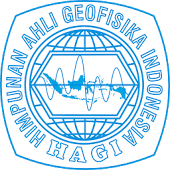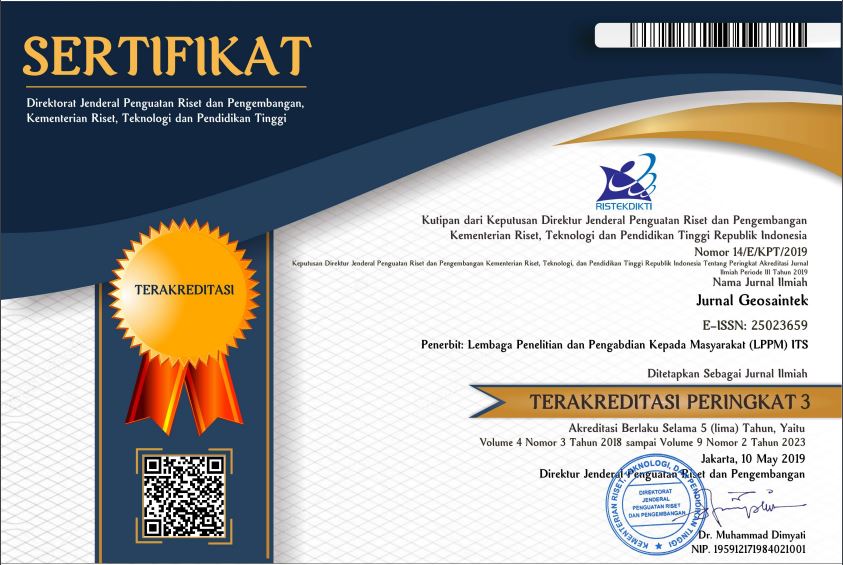Estimasi Karakteristik Durasi Rupture Pada Gempa Pembangkit Tsunami Studi Kasus: Gempa Bumi Nias, 28 Maret 2005
Abstract
Telah dilakukan penelitian tentang estimasi durasi rupture pada gempa bumi Nias, 28 Maret 2005 dengan tujuan untuk mengetahui karakteristik dari gempa bumi pembangkit tsunami. Lokasi Nias dipilih pada penelitian ini karena dampak yang diakibatkan oleh gempa bumi Nias sangat dan dapat berpotensi terjadi tsunami. Data yang digunakan adalah wave form dengan komponen vertikal yang memiliki coverage yang baik dan noise-nya kecil. Hasil dari estimasi durasi rupture pada gempa Nias di masing-masing stasiun yaitu FURI 129,28 detik, KMI 51,93 detik, WRAB 90,25 detik, DGAR 151,15 detik, dan GUMO 105,30 detik. Hasil estimasi durasi rupture tersebut berpotensi kuat terjadi tsunami karena lebih dari 50 detik.
Keywords
durasi rupture; Nias; tsunami
Full Text:
PDFReferences
Briggs, R.W., K. Sieh, A.J. Meltzner, D.H. Natawidjaja, dkk., 2006. Deformation and Slip Along The Sunda Megathrust in The Great 2005 Nias-Simeulue Earthquake. Science, 311 (5769), 1897-1901.
Geist, E. and Yoshioka, S., 1996. Source Parameters Controlling the Generation and Propagation of Potential Local Tsunami, Natural Hazards 13: 151-177.
Lomax, A., and Michelini A., 2005. Rapid Determination of Earthquake Size for Hazard Warning, EOS, Trans. Am. Geophys. Un., 86 (21): 202.
Lomax, A. and Michelini A., 2009. Mwpd: A Duration-Amplitude Procedure for Rapid Determination of Earthquake Magnitude and Tsunamigenic Potential from P Waveform. Geophysics.J.Int.,176:200-214,doi:10.1111/j. 1365-246X.2008.
Lomax, A. and Michelini, A., 2011. Tsunami Early Warning using Earthquake Rupture Duration and P-Wave Dominant Period: The Importance of Length and Depth of Faulting. Geophys. J. Int., 185: 283-291. Doi: 10.1111/j.136 246X.2010.
Madlazim., 2011. Estimasi CMT, Bidang Sesar dan Durasi Rupture Gempa Bumi Di Sumatera Serta Kemungkinan Penerapannya Untuk Sistem Peringatan Dini Tsunami. Institute Teknologi Sepuluh Nopember Surabaya (disertasi).
Meijde, M. V. D., 2005. Earthquake as Driving Mechanism Behind Tsunamis, International Institute for Geo Information Science and Earth Observation, (www.itc.nl/library/Paper_ 2005/tsunami/Earthquake.pdf).
Natawidjaya, D.H., 2002. Neotectonics of the Sumatera Fault and Paleogeodesy of the Sumatera Sudbuction Zone. California Institute of Technology Pasadena. California (Thesis).
Natawidjaya, D.H., 2007. Gempa Bumi dan Tsunami di Sumatera dan Upaya untuk Mengembangkan Lingkungan Hidup yang Aman dari Bencana Alam. Vol. 136.
Newcomb, K.R., and W. R. McCann., 1987. Seismic History and Seismotectonics of the Sunda Arc. Journal of Geophysical Research, 92: 421-439.
Okal, E. A., 1988. Seismic Paramters Controlling Far-field Tsunami Amplitudes: a Review, Nat. Hazard, 1: 67-96.
Rais, J., 2006. Indonesia di Antara Dua Samudera, Dua Benua, dan Tiga Lempeng Tektonik Mega, ITB, Bandung.
Rooke, N. Chamot., 2008. Stress Chage and Effective Friction Coefficient along the Sumatera-Andaman-Sagaing fault system after the 26 December 2004 (Mw = 9,2) and the28 March 2005 (Mw = 8.7) Eartquakes. Paris : AGU and Geochemical Society.
DOI: http://dx.doi.org/10.12962%2Fj25023659.v2i3.2101
Refbacks
- There are currently no refbacks.

Jurnal Geosaintek diterbitkan oleh ITS bekerja sama dengan Himpunan Ahli Geofisika Indonesia (HAGI)
Disebarluaskan di bawah Lisensi Creative Commons Atribusi-BerbagiSerupa 4.0 Internasional.
Berdasarkan ciptaan pada https://iptek.its.ac.id/index.php/geosaintek/index.





